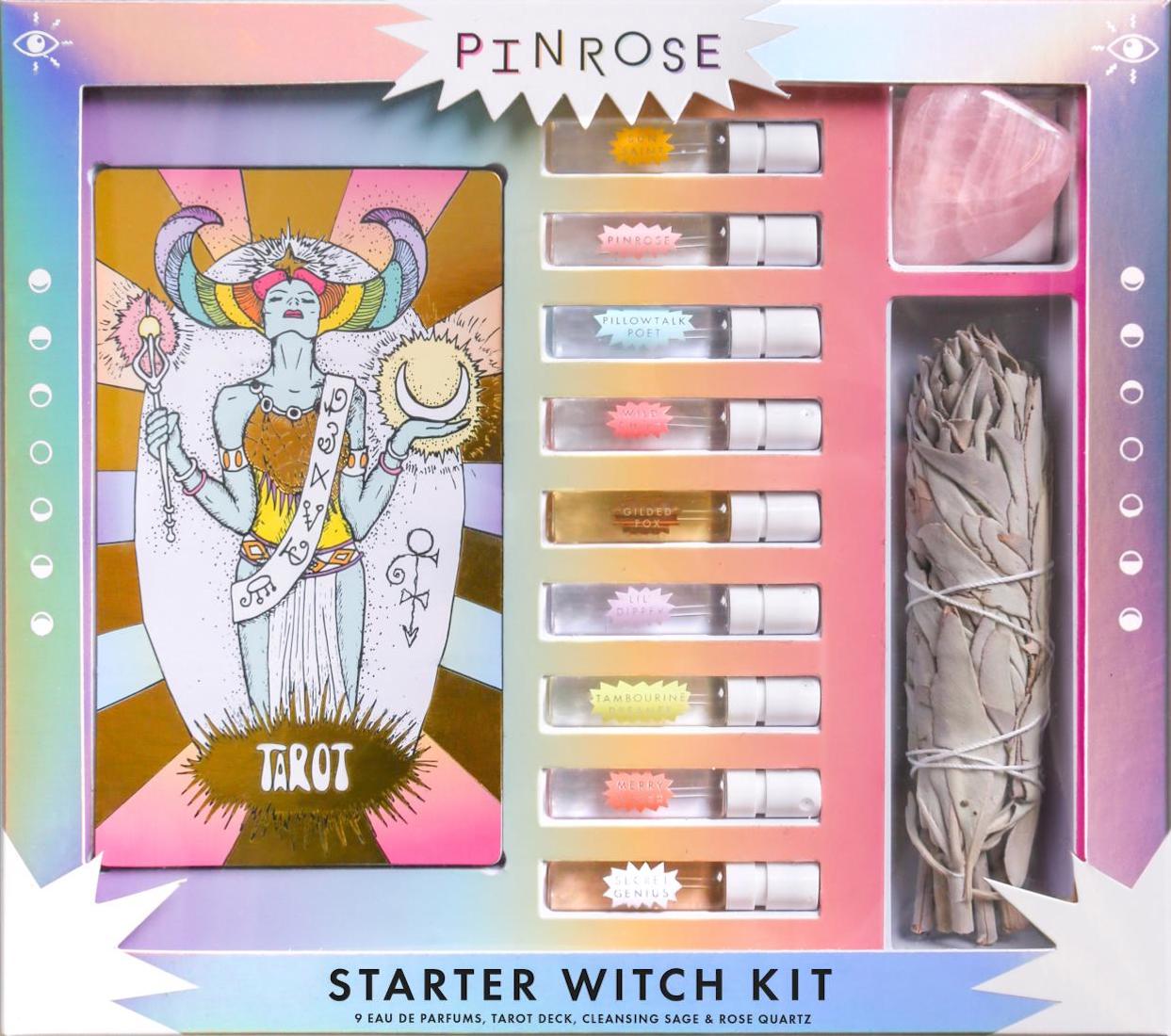So, I must admit, like many people interested in the practice of witchcraft, I’ve been intrigued by the recent controversy surrounding Sephora’s “Starter Witch Kit,” created in collaboration with the fragrance company Pinrose. The kits, which included a deck of tarot cards, a bundle of white sage, and a piece of rose quartz along with some small perfumes were meant to go on sale for a whopping $42 in October, but have been pulled from the market in response to general outrage from the witchcraft community. And while I’m a little late to the party in writing about this, I thought I’d put some of my own thoughts on this topic out there, mainly because it’s brought up a lot of questions pertaining to wider issues of cultural appropriation and spiritual theft.
The notion of cultural/spiritual appropriation is something that I’ve been thinking about for a while now, and an academic interest in the topic was actually how I stumbled upon Paganism in the first place, as I set out to write my undergraduate dissertation on spiritual “mixing” and “borrowing” at a local holistic wellness centre that happened to be run by Pagans. I’m not by any means saying that Paganism is necessarily spiritually or culturally appropriative—on the contrary, undertaking that project taught me quite a lot about navigating the dynamic boundaries between cultural appropriation and cultural mixing (or what I like to call “synthesis”). As a result, I’ve ended up with a lot of different (often conflicting) thoughts on the topic, to the point where I am constantly reevaluating where I stand on a number of implicated issues. And now, it seems that this Witch Kit controversy has become part of this discourse.
Cultural Appropriation?
Perhaps we should start with a definition of what cultural appropriation actually is. Generally, it can be defined as when members of a majority group adopt elements of a minority culture, often distorting their original meanings in the process. Usually, there is a lack of understanding with regards to the elements being appropriated, as well as failure to give credit where credit is due. As a result, these acts may be harmful or disrespectful to those whose culture is being exploited, especially when the majority group is benefiting from the elements that are being taken. So for instance, when a European fashion designer uses Native American patterns and motifs for a new collection without any regard for the cultural or spiritual significance of those designs, this is blatant cultural appropriation.
Spiritual appropriation or theft is similar, and pertains to the exploitation of indigenous and/or minority beliefs and practices. An example of this that I’m personally quite interested in is the phenomenon of “plastic shamanism,” wherein westerners learn about indigenous shaman traditions on a superficial level, and then attempt to sell this knowledge to others, using their traditional knowledge to make a hefty profit. Typically, the information they’re selling is exceptionally diluted, usually wrong, and often downright dangerous, and shows little to no respect for the culture from which it was stolen.
In cases like these, the occurrence of cultural appropriation or spiritual theft is obvious, and obviously wrong. But in many other instances, the line between appropriation and simply mixing is blurred, and concepts of right and wrong are not so clear. When is “appropriation” actually a real issue worth fighting for, and when is it just a case of social justice warriors getting their knickers in a twist?
I think ultimately, there is no clear answer to this, as these things always exist on a spectrum, and its up to us to decide where we locate each incident. And in a lot of cases, deciding where to stand on a particular issue is much more complicated than it seems. Like with these Witch Starter Kits—I’ve got to admit I’m not 100% sure what I think about this within the framework of appropriation.
Cultural Appropriation and Historical Oppression
On the one hand, I completely understand why people within the witchcraft community are upset about the product. Witches are, in a way, a marginalized group whose practices, beliefs, and symbols are being commercially exploited by a major company that likely knows very little about witchcraft as a practice, or Wicca as a religion.
On the other hand, all of this outrage does seem to be blown somewhat out of proportion to me. Especially because contemporary witchcraft is already seeped in consumer culture as it is.
On some level, the controversy brings to mind something a Native American woman I met at a colloquium on cultural appropriation spoke about. This women, whose family had been tortured and killed by white Canadians, and who had herself spent the majority of her youth suffering through the tortured misery of the residential schools designed to destroy her culture, said that she nearly broke down in tears one day when she saw that her local dollar store was selling flimsy “make your own dreamcatcher” kits for two bucks a pop. She was absolutely devastated that the people who had put her and her ancestors through such hell were now profiting off a cheap farce of the culture they had not too long ago attempted to abolish—a culture that they almost certainly did not respect or understand. And while this story raises questions with regards to history and blame, as well as cultural appropriation, I think that it can also provide an interesting point of comparison for the Sephora’s Witch Kits, which are also cheap (actually, way over priced) knock-offs of a particular spiritual tradition.
But the big difference here, of course, is that contemporary witchcraft does not share the same history of oppression and devastation that Native American peoples have experienced over generations. While witches are often marginalized and shunned by mainstream society, they have not been exposed to the horrors of mass genocide, or sterilization, or the deprivation of residential schools. Though its true that “witchcraft” as an idea is connected to the witch trials of the 17th century, the practice of contemporary witchcraft (and the Wiccan religion) in actuality has very little to do with these past events.
The question here, however, is: does it matter?
Does it matter that witches, as a minority group, have suffered less than other groups who have had various cultural elements exploited by mainstream culture? Should it matter? Or should we see cultural appropriation as cultural appropriation, regardless of historical oppression? Should we, or can we, even compare these instances of appropriation at all?
Personally, while I am a huge advocate for the fact that history does matter, and we need to be cognisant of such past events, I also don’t think that this matter of the Witch Kits should be trivialized simply because witchcraft as a spiritual practice has not been as deprived by mainstream culture as certain indigenous groups. First, because contemporary witchcraft does have its own history of marginalization that should not be disregarded, and second, because there are people who are obviously hurt by this product, whose voices should be (and have been) taken into account.
However, that being said, I find it interesting that many of the people that I’ve noticed to be the most outraged about the Witch Kits are self-proclaimed “Insta-Witches,” and are therefore themselves highly involved in the “witch aesthetic” trend, often profiting off of it in one way or another.
Witchcraft and Consumerism
Like I mentioned earlier, a lot of contemporary witchcraft is already highly commercialized, and many high-profile witches on social media are also makeup gurus and fashionistas. And while I don’t personally think that spending hours achieving that cat’s eye or capturing the perfect flatlay necessarily detracts from genuine spiritual practice or fulfillment, I do think it has the potential to. And I’m not alone in thinking this—scholars on contemporary witchcraft have noticed a trend in the consumption of goods as a counterpoint to or distraction from true spiritual transformation, and have even started to distinguish between popular, “commodified witchcraft” and genuine “traditional witchcraft.”
While I don’t believe that there’s necessarily anything wrong or non-spiritual about consumerism (its impossible to escape in today’s society anyways), or any hard division between popular and traditional witchcraft, I have noticed that a lot of younger people do seem to be attracted to the craft (at least initially) for its aesthetic, rather than spiritual appeal. And while this is a discussion for another post, I do find it interesting that some of the people most upset by these Sephora kits are also the most invested in the aesthetic aspects of witchcraft.
So, what conclusions can be drawn from this? What does this mean? Maybe something, maybe nothing at all. Either way, I think that this is an important topic to reflect on because of the larger questions it opens up pertaining to cultural and spiritual appropriation.
For myself, it’s got me thinking about the ways in which I personally engage in forms of spiritual appropriation. For instance, I implement various witchcraft practices, and borrow elements of Wiccan ritual, yet I don’t consider myself to be a witch. A Pagan, yes. But not a witch, and certainly not a Wiccan. So, is that appropriation?
Similarly, I also have a Buddha statue on my altar, and I use various Hindu mantras in my meditation practice, yet I would never consider myself to be a Buddhist or a Hindu. To what extent is that appropriation, and to what extent should I be expected to reconsider these practices?
I think that a deeper exploration of these questions deserves a future blog post of its own, but in general I believe that they are important things to keep in mind. Ultimately, I think that regardless of what we call it—“appropriation,” “theft,” “mixing,” “synthesis”—it’s important to remain conscious that traditions, beliefs, symbols, etc. all originated within a particular cultural context at a particular time, and that taking them out of that context for our own use does significantly change them. And while this change isn’t necessarily a bad thing, and can at times be highly spiritually meaningful or fulfilling, we always need to remain conscious and respectful of the contexts we are extracting these elements from. Otherwise, we run the risk of hurting others in potentially profound ways, which is something that, as a Pagan (and a socially conscious human being), I actively strive to avoid.


